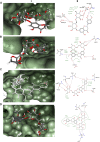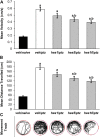Hesperidin Interacts With CREB-BDNF Signaling Pathway to Suppress Pentylenetetrazole-Induced Convulsions in Zebrafish
- PMID: 33505312
- PMCID: PMC7832091
- DOI: 10.3389/fphar.2020.607797
Hesperidin Interacts With CREB-BDNF Signaling Pathway to Suppress Pentylenetetrazole-Induced Convulsions in Zebrafish
Abstract
Hesperidin (3,5,7-trihydroxyflavanone 7-rhamnoglucoside) is a β-7-rutinoside of hesperetin (4'-methoxy-3',5,7-trihydroxyflavanone), abundantly found in citrus fruits and known to interact with various cellular pathways to show a variety of pharmacological effects. The present study was envisaged to understand the anticonvulsant effect of hesperidin in a zebrafish model of pentylenetetrazole (PTZ)-induced convulsions, with the support of in silico docking. Healthy zebrafish larvae were preincubated with hesperidin (1, 5, and 10 µM) for 1 h, before PTZ exposure. Hesperidin treatment significantly increased the seizure latency and minimized PTZ-induced hyperactive responses. A significant reduction in c-fos expression further supported the suppression of neuronal excitation following hesperidin incubation in the larvae exposed to PTZ. The treatment also modulated larval bdnf expression and reduced the expression of il-10. The results of in vivo studies were further supported by in silico docking analysis, which showed the affinity of hesperidin for the N-methyl-d-aspartate receptor, the gamma-aminobutyric acid receptor, Interleukin 10 and the TrkB receptor of brain-derived neurotrophic factor. The results concluded that hesperidin suppresses PTZ-mediated seizure in zebrafish larvae through interaction with the central CREB-BDNF pathway.
Keywords: brain-derived neurotrophic factor; c-fos; clonic-like seizures; epilepsy; flavanone glycoside; il-10; in silico docking; zebrafish larva.
Copyright © 2021 Singh, Sharma, Kumari, Sharma and Purohit.
Conflict of interest statement
The authors declare that the research was conducted in the absence of any commercial or financial relationships that could be construed as a potential conflict of interest.
Figures





Similar articles
-
Anticonvulsant action of a selective phosphatidylinositol-3-kinase inhibitor LY294002 in pentylenetetrazole-mediated convulsions in zebrafish.Epilepsy Res. 2019 Nov;157:106207. doi: 10.1016/j.eplepsyres.2019.106207. Epub 2019 Sep 17. Epilepsy Res. 2019. PMID: 31563029
-
Berberine and hesperidin prevent the memory consolidation impairment induced by pentylenetetrazole in zebrafish.Behav Brain Res. 2024 May 28;466:114981. doi: 10.1016/j.bbr.2024.114981. Epub 2024 Apr 4. Behav Brain Res. 2024. PMID: 38580198
-
Indomethacin treatment prior to pentylenetetrazole-induced seizures downregulates the expression of il1b and cox2 and decreases seizure-like behavior in zebrafish larvae.BMC Neurosci. 2016 Mar 9;17:12. doi: 10.1186/s12868-016-0246-y. BMC Neurosci. 2016. PMID: 26961169 Free PMC article.
-
Therapeutic potential of CB1R activation by Qingyangshen glycoside M1 for seizure relief.J Ethnopharmacol. 2024 Jun 12;327:117982. doi: 10.1016/j.jep.2024.117982. Epub 2024 Feb 27. J Ethnopharmacol. 2024. PMID: 38423411
-
Anticonvulsant and anti-apoptosis effects of salvianolic acid B on pentylenetetrazole-kindled rats via AKT/CREB/BDNF signaling.Epilepsy Res. 2019 Aug;154:90-96. doi: 10.1016/j.eplepsyres.2019.05.007. Epub 2019 May 13. Epilepsy Res. 2019. PMID: 31112902
Cited by
-
Zebrafish: A Model Deciphering the Impact of Flavonoids on Neurodegenerative Disorders.Cells. 2023 Jan 7;12(2):252. doi: 10.3390/cells12020252. Cells. 2023. PMID: 36672187 Free PMC article. Review.
-
The Role of Brain-Derived Neurotrophic Factor in Epileptogenesis: an Update.Front Pharmacol. 2021 Nov 26;12:758232. doi: 10.3389/fphar.2021.758232. eCollection 2021. Front Pharmacol. 2021. PMID: 34899313 Free PMC article. Review.
-
A Comprehensive Review on Anti-Inflammatory Response of Flavonoids in Experimentally-Induced Epileptic Seizures.Brain Sci. 2023 Jan 5;13(1):102. doi: 10.3390/brainsci13010102. Brain Sci. 2023. PMID: 36672083 Free PMC article. Review.
-
Phytocannabinoids Reduce Seizures in Larval Zebrafish and Affect Endocannabinoid Gene Expression.Biomolecules. 2023 Sep 16;13(9):1398. doi: 10.3390/biom13091398. Biomolecules. 2023. PMID: 37759798 Free PMC article.
-
Roles of N-Methyl-D-Aspartate Receptors (NMDARs) in Epilepsy.Front Mol Neurosci. 2022 Jan 7;14:797253. doi: 10.3389/fnmol.2021.797253. eCollection 2021. Front Mol Neurosci. 2022. PMID: 35069111 Free PMC article. Review.
References
-
- Berendsen H. J. C., Postma J. P. M., Van Gunsteren W. F., Dinola A., Haak J. R. (1984). Molecular dynamics with coupling to an external bath. J. Chem. Phys. 81, 3684–3690.
LinkOut - more resources
Full Text Sources
Other Literature Sources
Molecular Biology Databases

